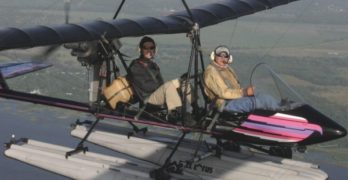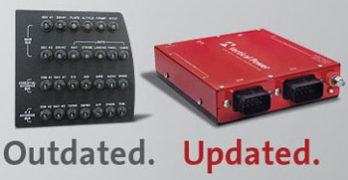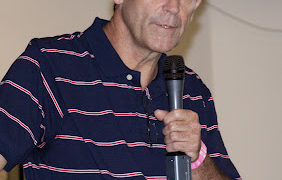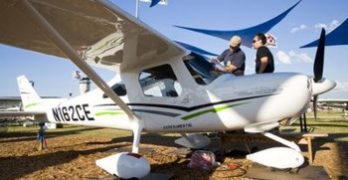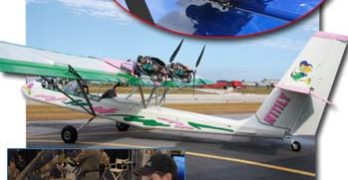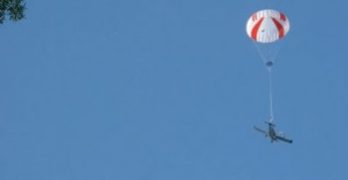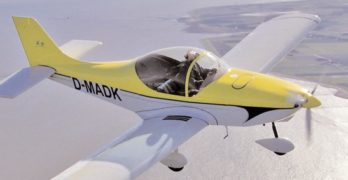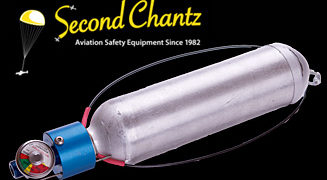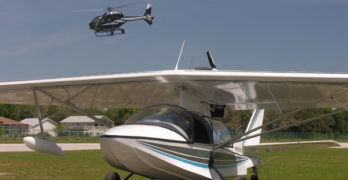Things can change and yet stay the same. You can comprehend this paradox by considering the tandem 2-seat Drifter. Drifter production is under new management by someone many regard as a “rightful owner.” Yet the basic flying qualities of the Drifter design are basically unchanged.
As 2007 started, Phil Lockwood again has all rights to the Drifter as part of a design, tooling, and inventory deal that rescued the Drifter and 2-seat twin-engine Air Cam from an uncertain future with investor Antonio Leza, who ran the operation for a few years.
Lockwood is associated with the Drifter due to his many years of work with the design. He once worked for Maxair proprietor Denny Franklin who pioneered this enduring shape. In the rough and tumble days of early ultralights, Franklin lost control of Drifter ownership and for a time the design wandered. More correctly, the new owners failed to take the Drifter forward and instead merely exploited its popularity.
Search Results for : BRS parachute
Not finding exactly what you expected? Try our advanced search option.
Select a manufacturer to go straight to all our content about that manufacturer.
Select an aircraft model to go straight to all our content about that model.
Electronic Circuit Breakers and Runway Seeker
Does the idea of electronic circuit breakers (ECB) make you yawn and look around for something more interesting? I understand, but this is truly a cool product. ECB developer Vertical Power also offers a related and extremely compelling product. After visiting with Marc Ausman at Sun ‘n Fun, again at AirVenture 2012, and then with several LSA builders, I got over the yawn reflex and realized Vertical Power is a most progressive company, one that deserves additional attention.
Update Note — This article has been updated after Vertical Power was acquired by Astronics and placed with a division named Ballard Technology. Please see note in red text below and click here to learn more about Vertical Power.
First, the VP-X. This shiny red box is the third generation of ECBs. The first two depended on their own screen to show their benefits. The VP-X model now works with five major suppliers of EFIS avionics including Dynon, Garmin, MGL, GRT, and Advanced.
Sun ‘n Fun 2012: Day Five Part 3ree
Photo Wrap Up: Some other stories that will get fleshed out down the road here and in the magazine. Sun ‘n Fun ends tomorrow. Long Live Sun ‘n Fun.
Skycatcher Crash #2
No details yet from Cessna on the crash of its second Skycatcher (AKA Cessna 162). According to numerous online reports, the SLSA production prototype crashed March 19 while on a flight test near Wichita, Kan. *** A Kansas cable tv news channel posted a story online that claimed the plane landed under a BRS ballistic airframe parachute canopy, hit a fence and flipped over. *** Good news: the pilot was not injured. *** That’s about all the good news though for Cessna, which had reworked the vertical stabilizer and rudder after its first prototype crashed in a stall-spin accident last fall. *** According to Cessna personnel, the company had conducted further wind tunnel tests after the first crash, then picked one of two aerodynamic solutions which led to the tail mod. *** A Cessna spokesman also commented on a recent online video that Cessna had begun production on the Skycatcher at the Shenyang Aircraft Corporation, China plant.
Air-Cam Developments under Lockwood Leadership
Air-Cam isn’t a Light-Sport Aircraft because it has two engines. OK, it’s also a shade heavy but if Air-Cam could, it would be a LSA. Certainly it’s “light” and “sport” compared to most twins. Regardless, it’s a favorite of all the airplanes I’ve flown so I’m pleased to see its rapid progress under the leadership of Phil Lockwood, the original developer. *** The latest accomplishment is a factory-authorized amphibious float system from Montana Floats that includes all mounting hardware. As though it needed any more power — Air-Cam is the only multiengine airplane I’ve flown that can launch with one engine — the twin pusher can now be equipped with two Rotax 914 Turbos. Combined with the extra power (230 hp total), Air-Cam can be fitted with a constant speed reverse pitch prop system ideal for float-equipped Air-Cams. A new rigid mount can now accommodate High Definition video cameras…it is, after all, the Air-CAM.
Evektor SportStar Chute Deploy
An
anonymous source sent me an account (in Czech) and photos of an incident in Czech Republic that reportedly occurred when an Evektor SportStar, flown by an “experienced pilot”, was unable to recover from a spin. *** It happened on May 18 over a lake near Ostrozska Ves. You can see the pilot climb out of the cockpit once it hit the water, before the aircraft sunk. *** These are some of the best photos I’ve ever seen of an actual deployment, rivaling the YouTube video of an Argentine Rans pilot doing aerobatics and suffering a wing loss in negative G yet was saved by the airframe ‘chute at an extremely low altitude — a real heart stopper, that one. *** The Czech ambulance staff called to the scene treated the Evektor pilot for bruises and exposure. He was otherwise uninjured… very good news! *** Because Lake Ostrozska is an important source of drinking water for a large surrounding population, there was considerable concern that the 17-plus gallons of gas still onboard might escape from the plane and kick off an “environmental disaster,” according to an online Czech news source.
Flying Cessna’s LSA Skycatcher
Honestly, I never thought I’d see this day arrive. As I started work
on a Cessna aircraft review for the pages of Light Sport and
Ultralight Flying magazine, I thought, We’ve come a long way.
When this publication was started 35 years ago, it was titled Glider Rider
and it featured hang gliders. Coverage then expanded to include powered
ultralights, and now light-sport aircraft (LSA) are included in the mix.
This month I’ve written a pilot report on Cessna Aircraft’s Skycatcher
LSA, the first Cessna in modern memory not built to FAR Part 23 standards,
that is, not type-certified by the U.S. government. Some may say ultralights
“grew up” to become light-sports. But I say that Cessna has moved
(returned?) to very light aircraft designs. I consider their arrival significant.
It isn’t simply that you can buy a brand-new Cessna for $112,500 (more on
the price later). The more important point to Light Sport and Ultralight
Flying readers is that the Skycatcher flies similarly to what light aircraft
enthusiasts fly.
Breezer Aircraft and the New Breezer II
Close to Perfect
It usually takes more than one
try to get something right. To
get close to a perfect aircraft
usually takes many iterations, but
Breezer Aircraft has come very close
to producing a wonderful light sport
aircraft with their Breezer II.
We’ve seen the Breezer before when
the U.S. importer brought the thennew
model to AirVenture Oshkosh
’05. I flew it that year and recently
got the chance to fly the Breezer II.
While many of the good qualities
found in the earlier model were
retained, some nice improvements
have been made. But it isn’t the airplane
that is the real story. As experienced
airplane buyers know, it is
often the company behind the airplane
that is the main story.
Breezer’s Brief Design History
The design history is brief because the Breezer
is a new aircraft, not seen before ’05 except during
its early development. That older, original Breezer
was produced under agreement by Comco-Ikarus,
the same folks that make one of Germany’s bestselling
ultralights (a different class than American
ultralights), the C-42.
Second Chantz… for the Second Time
On ultralight aircraft, the installation of an airframe parachute was estimated at a third to half of all aircraft. In general aviation, the use of such a system on the Cirrus Design line of aircraft created thousands of airframe parachute owners. In Light-Sport, three producers — BRS, Magnum (Stratos 07), and Galaxy — have installed airframe parachutes on a solid percentage of SLSA. Sounds like it’s all taken care of, right? Wrong! *** The trouble with existing producers is that little or no new development work is being done for Part 103 ultralights, powered parachutes, or trikes. Likewise many kit-built aircraft have no supplier willing to customize an airframe parachute for their (possibly one-off) airplane. Now, that’s changing. *** An old friend, John Dunham, once ran Second Chantz, the other airframe parachute company in the USA (besides BRS). In the mid-’90s, he made a deal with BRS and left the business.
SeaRey… American-Made Amphibian
SeaRey Sets a New Standard for Floatplanes
Many pilots who have flown in water-borne aircraft believe this is the
finest and most enjoyable flying one can do.
If that statement holds water (is true), then the beautiful SeaRey amphibian
from Florida-based Progressive Aerodyne should be one of the most desirable
aircraft you can buy.
Pilots have spoken with their money. Since it arrived on the market in 1992,
the SeaRey has sold in increasing numbers each year.
Three years of Progressive Aerodyne history hardly tells the story behind
the SeaRey. A father and son ownership team, Wayne and Kerry Richter have
long experience in this business producing many hundreds of amphibious
ultralights.
The Richters were principals in a company called Advanced Aviation best
known for its amphib sea plane called the Buccaneer. After another designer
made the first single place Buccaneer, Kerry Richter made his name with a
two place model.
- « Previous Page
- 1
- …
- 9
- 10
- 11
- 12
- 13
- …
- 18
- Next Page »


